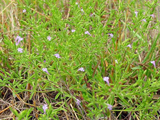Native Plants

Q. Who is Mr. Smarty Plants?
A: There are those who suspect Wildflower Center volunteers are the culpable and capable culprits. Yet, others think staff members play some, albeit small, role. You can torture us with your plant questions, but we will never reveal the Green Guru's secret identity.
Did you know you can access the Native Plant Information Network with your web-enabled smartphone?
Ask Mr. Smarty Plants is a free service provided by the staff and volunteers at the Lady Bird Johnson Wildflower Center.

rate this answer
Wednesday - February 19, 2014
From: Rosanky, TX
Region: Southwest
Topic: Erosion Control, Groundcovers, Grasses or Grass-like
Title: Native plants and grasses for river bank from Rosanky TX
Answered by: Barbara Medford
QUESTION:
Our property owners association would like to know what native plants/grasses to plant on the Blanco River bank in our river park to help prevent erosion. Some banks are steep and some areas are a gradual slope. Members want to know if it is preferable to leave downed trees and flood debris where they fall to prevent future erosion or if the better plan is to remove them and plant new trees and grasses. Our main goals are to protect our riverbank while also making sure property owners have access to enter the river and enjoy the water. Thank you for your help!ANSWER:
To answer your last question first, we would never recommend leaving debris, including fallen trees, on the ground. After all, you are in Bastrop County, and we understand we are already entering a period of Fire Danger warnings in Central Texas. Plus, it would be more difficult to plant and care for groundcovers with that debris present.
You mentioned steep banks but did not tell us about the sunlight available, so we are going to do a combination search on our Native Plant Database for groundcovers - some will be low and some will be high, so you will need to follow each plant link to our webpage on that plant, paying special attention to the growing conditions of each. We will check each to make sure it is native to your area before we add it to the list. Follow each plant link to our webpage on that plant, comparing water needs, size and growing conditions with what you are looking for.
First, some groundcovers that will do all right without too much sun - From a previous Mr. Smarty Plants answer for Austin:
Low groundcovers for part shade to shade in Central Texas:
Carex planostachys (Cedar sedge)
Low herbaceous blooming plants for part shade to shade in Central Texas.
Amblyolepis setigera (Huisache daisy)
Callirhoe involucrata (Winecup)
Calyptocarpus vialis (Straggler daisy)
Chamaecrista fasciculata (Partridge pea)
Dichondra argentea (Silver ponyfoot)
Glandularia bipinnatifida (Purple prairie verbena)
Hedeoma drummondii (Drummond's false pennyroyal)
Now, here are some taller grasses, for varying amounts of sun:
Andropogon gerardii (Big bluestem)
Aristida purpurea (Purple threeawn)
From the Image Gallery
More Erosion Control Questions
Erosion control on partially shaded slope
November 27, 2010 - Mr. Smarty Plants,
I live in Atlanta, GA. My house is on a hill, and I am beginning to have erosion at my backyard porch (concrete slab, on the corners especially). The soil is mainly red clay, a...
view the full question and answer
Plants for erosion control on steep bank in Minnesota
October 21, 2008 - I live in the Twin Cities of Minnesota. I have a steep slope in back yard which gets considerable rain runoff from the homes above me. What plants/shrubs/trees could I plant on the slope to stop the...
view the full question and answer
Smoky Mountains Shaded Slope Plant Suggestions
April 29, 2013 - We live in a very shady spot in Great Smoky Mountains in Western North Carolina. We would like to plant vegetation on a sloped area behind our cottage to stop erosion after building an addition. Our h...
view the full question and answer
Plants to prevent erosion in IL
August 02, 2012 - We just got done building a house and have leveled all of the dirt piles. We do have a row of straw bales to help prevent the dirt from washing onto the neighbors property. It is the wrong time of ye...
view the full question and answer
Shade tolerant plants for erosion from Austin
May 03, 2014 - I live in Austin and my house backs up to Shoal Creek. I am looking for a native creeping vine or something that will grow on the shaded bank to help prevent erosion. It should be able to tolerate the...
view the full question and answer
| Support the Wildflower Center by Donating Online or Becoming a Member today. |

